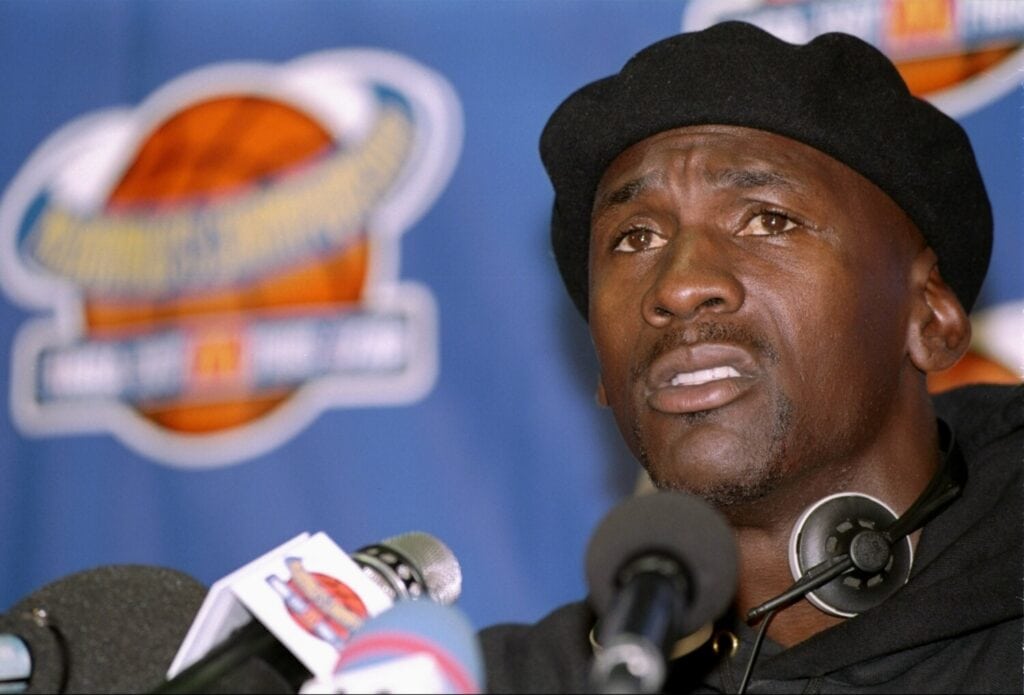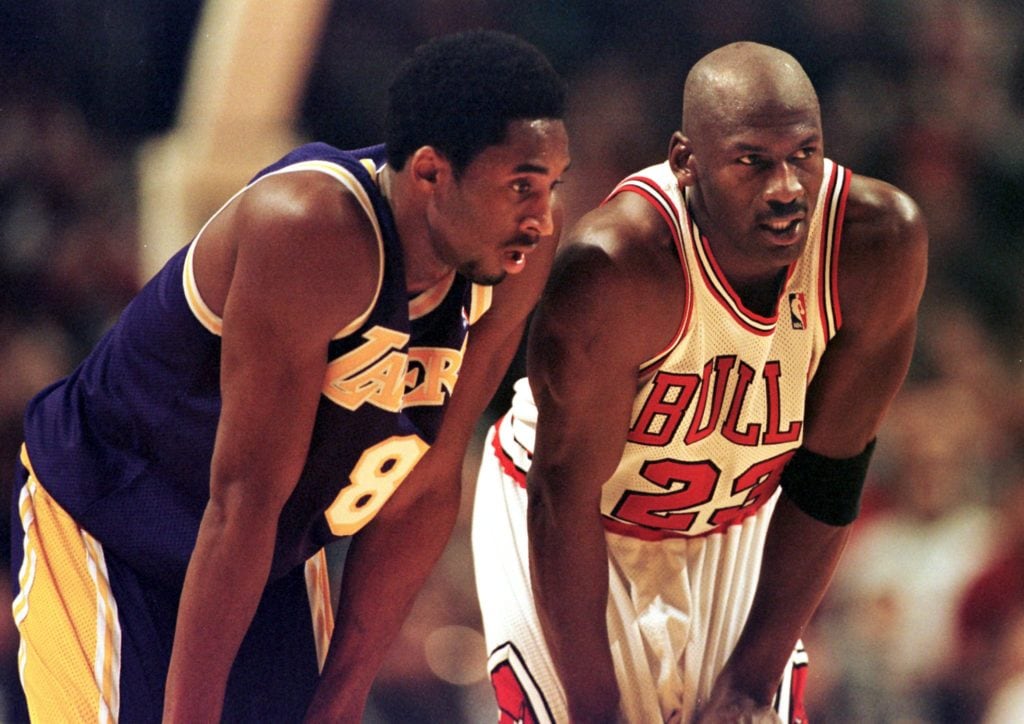How MJ’s final run in Chicago netted a record-setting salary, millions of eyeballs, and billions in economic impact.
25 years ago, Michael Jordan played his last game as a Chicago Bull.
The storybook ending — a game-winner in Utah to clinch his sixth NBA Championship and second threepeat — turned the page for basketball’s signature superhero, allowing MJ to retire his red cape and eventually take his talents from the backcourt to the front office.
But what if we told you MJ’s ascent from All-Star scorer to billionaire businessman was taking shape long before he took that last shot?
“Michael’s a very intelligent person,” legendary agent David Falk told Boardroom. “He listened, attended a lot of meetings, and met a lot of very successful people early in his career like Warren Buffet and Phil Knight.”
Using every opportunity as an apprenticeship, Mike’s competitive curiosity served him well as he rose from endorser to executive. This allowed him to strike not just when the iron was hot, but when it was sizzling.
“Michael’s unique,” Falk said. “He went out of his way to learn people’s secrets to success as he formulated his own approach.”
An approach often imitated but never duplicated.
Looking back at that seminal season, Boardroom breaks down the revolutionary business moves that MJ and Falk made to fully maximize Mike’s Last Dance in Chicago.
The $33 Million Season
In 1998, Fortune estimated Michael Jordan had a $10 billion impact on the economy. Perhaps he meant even more to Chicago.
“The Chicago Tribune once did a story that Michael meant a trillion dollars to the economy of Chicago,” PTI’s Michael Wilbon told Boardroom. “And it quantified it with economists and financial experts explaining why.”
From restaurant receipts to hotel tabs, MJ moved the needle on Windy City wealth every night he played. In 1996, Jordan’s Bulls balled out by going 39-2 at home ahead of the playoffs, ending the campaign with a fourth NBA Title and another massive parade.
That historic 72-10 season also culminated with the end of MJ’s eight-year, $27.5 million deal he signed in 1988.

No longer under contract in Chicago and being courted by both retirement and the New York Knicks, MJ and his agent had all the leverage in the world to rewrite the rules on what the face of the city — and league — was worth.
Heading into the 1996-97 season, the NBA salary cap was at $24.3 million. Literally larger than the league, Jordan signed a one-year deal worth $30 million.
“We changed the market dramatically,” Falk said. “We were the first two $100 million contracts with Alonzo Mourning and Juwan Howard. Michael had the first $30 million year.”
Dynamic deals were nothing new to Falk and it was well warranted for his most valuable client. When MJ earned the NBA’s first $30 million single-season contract, he made good on ownership’s investment by winning yet another ring.
When entering negotiations for MJ’s assumed-to-be last single-season deal in Chicago, Bulls team owner Jerry Reinsdorf had a hundred million reasons to pay MJ what he was worth.
Well, actually twice that.
Back in 1985, Reinsdorf acquired 56% of the Chicago franchise for $9.2 million right after MJ’s Rookie of the Year arrival. Over time, Jordan took the Bulls to a $200 million valuation in 1997 following the team’s fifth title.
For the math majors at home, that equates to 1,000% ROI for MJ where the Bulls organization is concerned.

While Reinsdorf reaped the benefits in his bank account, fans felt it every night their hoops hero was in town.
“There was nothing like the electricity that it brought to the city,” Wilbon said. “Nothing.”
To keep the Windy City alive and thriving, bringing back MJ for one final season — and paying him what he was worth — meant everything for the confidence and economy of Chicago.
“It defined a lot of things about the city,” Wilbon said. “It eliminated the second-city feel to New York. We felt inferior to New York, Michael changed that and the energy of the city reflected that in his time there.”
Coming off a fifth title, it was estimated that Reinsdorf could earn upwards of $135 million on ticket sales alone in what was being deemed the Last Dance for Michael Jordan. To put that in perspective, Chicago’s United Center cost $175 million to build in 1994.
“Rush Street had been a scene since Al Capone was running the place, but the social vibe was so different,” Wilbon said. “[Jordan] changed everything about the civic nature of the city. It changed race relations.”
In the summer of 1997, negotiations on MJ’s final contract in Chicago took place. To no surprise, Falk broke his own record — and the league’s — by getting MJ inked to a single-season salary of $33.1 million.
“I never wanted to make deals like everybody else,” Falk said. “I wanted to make deals that I thought were appropriate for my clients.”

Not only was MJ’s last season in Chicago enormous in regard to annual salary, it was also an outlier in the NBA market.
Patrick Ewing, also a Falk client and a big man playing in America’s biggest market, was making just over $18 million a year when he led the league in salary in 1996 and 1999. Jordan, despite playing in the smaller market of Chicago, was earning almost double that for 1997-98 season on the court alone.
Even more impressive? Mike’s money mark from that final year in Chicago stood the test of time. It would take two decades for any NBA player to make more on the court in a single season.
This happened 20 years later when the Warriors paid Stephen Curry $34.6 million in 2017-18. Though the economics of the league itself have evolved, the juxtaposition of Jordan to his peers remains revered.
“Today, the salary cap is $130 million,” Falk said. “And the highest-paid guy is barely making double what Michael made — and the cap’s gone up five times.”
Chicago and its economy won tremendously thanks to MJ’s last season in Chicago, but the Windy City wasn’t alone.
The Man in Every Market
On Oct. 10, 1997, Michael Jordan officially inked a one-year deal with the Chicago Bulls for a last dance worth $33.1 million, cementing his value to his franchise and his city.
One week later, he hopped on a plane to play the first game of his quest for his sixth title: an exhibition outing in France, sponsored by McDonald’s, a brand already partnered with MJ.
Because of Jordan’s influence, tickets and apparel associated with the Bulls sold in abundance outside of Chicago and even abroad.

While this trend feels commonplace today, such a massive market share in sports fandom was a phenomenon before Jordan.
“When Michael came in the league he broke every barrier that existed,” Falk said. “People didn’t believe on Madison Avenue that an African-American team sport athlete could be nationally marketed. People thought that team sport athletes were inherently popular only in the city where they played.”
With MJ, that notion was simply not true. Over the course of his Last Dance season, Michael Jordan and his Chicago team broke registers not just in Illinois but everywhere they went.
“The Bulls were the traveling Beatles,” Action Network’s Darren Rovell told Boardroom. “Michael Jordan has a glow about him. I was in Chicago in ’96, ’97, and ’98 so I know how hard it was to get a ticket.”
Just as Mike made tickets hard to get at home, he made them easy to sell no matter where he went. While this was true his entire career, it was more so during the Last Dance.
At the end of his last season in Chicago, CNN reported that MJ accounted for $30.5 million in ticket sales strictly on the road over the course of his career. This meant strong sales from Vancouver to Orlando as Mike laced them up all 82 games in each year of the final three-peat.
While Michael had the ability to impact box offices far removed from his native market, he also had the ability to drive ratings through the roof across the country.
When Jordan first signed with Chicago in 1984, fans had to attend games in person or catch games locally on WGN. Back then, CBS was paying $22.9 million annually for NBA network rights while TBS was getting to broadcasts league games on cable for $10 million a year.
Once word got out about the airborne antics of Jordan, everything exploded.
By 1997, NBC was paying $223 million to show games while the league taxed Turner a whopping $99.2 million for cable rights.
As a network, NBC ate off each MJ opportunity during the Last Dance, getting the chance to sell the 1998 NBA All-Star Game in Madison Square Garden as a passing of the torch moment between Jordan and the teenage talent, Kobe Bryant.
Around the league, the matchup in the Mecca was being billed as must-see TV.
“We all knew the rumblings that it was supposed to be Michael’s last year playing,” Antoine Walker told Boardroom in 2022. “We knew Kobe was an exciting guy coming out of high school and had some Jordan-ness to his game. We know Kobe was special, but his competitive drive to be like Mike was something to watch.”
It was something to watch for viewers at home as 16.9 million fans tuned in.

Fittingly, Michael made the most of the moment by winning All-Star Game MVP and debuting a new color of his Air Jordan 13 sneakers.
The footwear moment was fortuitous for all involved. Fittingly, the thematic “Playoff” colorway debuted in NYC would resurface on screen that same spring in the postseason when Mike ran up the TV numbers again for NBC.
On his feet would be more models made in his image, proving prowess to earn in abundance for years after his TV time faded to black.
Tune in later this week for Pt. 2 as Boardroom expands into the off-court business built by MJ during his last season in Chicago.